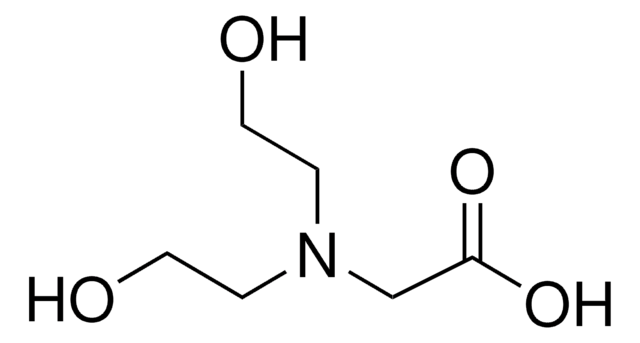Kluczowe dokumenty
T0377
Tricine
≥99% (titration)
Synonim(y):
N-[Tris(hydroxymethyl)methyl]glycine
About This Item
Polecane produkty
Próba
≥99% (titration)
Formularz
crystalline powder
przydatny zakres pH
7.4-8.8
pKa (25°C)
8.1
mp
187 °C
rozpuszczalność
water: 0.25 g/mL, clear, colorless
Zastosowanie
diagnostic assay manufacturing
ciąg SMILES
OCC(CO)(CO)NCC(O)=O
InChI
1S/C6H13NO5/c8-2-6(3-9,4-10)7-1-5(11)12/h7-10H,1-4H2,(H,11,12)
Klucz InChI
SEQKRHFRPICQDD-UHFFFAOYSA-N
Szukasz podobnych produktów? Odwiedź Przewodnik dotyczący porównywania produktów
Opis ogólny
Zastosowanie
- to prevent precipitation of salts during autoclaving of Emiliania huxleyi cultures
- as a component of buffer A for the homogenization of samples like Caenorhabditis elegans, Drosophila, and plants
- as a component of fresh assay buffer to measure serum melatonin by radioimmunoassay
Kod klasy składowania
11 - Combustible Solids
Klasa zagrożenia wodnego (WGK)
WGK 3
Temperatura zapłonu (°F)
Not applicable
Temperatura zapłonu (°C)
Not applicable
Środki ochrony indywidualnej
Eyeshields, Gloves, type N95 (US)
Wybierz jedną z najnowszych wersji:
Masz już ten produkt?
Dokumenty związane z niedawno zakupionymi produktami zostały zamieszczone w Bibliotece dokumentów.
Klienci oglądali również te produkty
Protokoły
This procedure may be used for Collagenase products.
Nasz zespół naukowców ma doświadczenie we wszystkich obszarach badań, w tym w naukach przyrodniczych, materiałoznawstwie, syntezie chemicznej, chromatografii, analityce i wielu innych dziedzinach.
Skontaktuj się z zespołem ds. pomocy technicznej






![N-[3-(2-Furyl)acryloyl]-Leu-Gly-Pro-Ala](/deepweb/assets/sigmaaldrich/product/structures/805/876/96b5fb57-71c8-4c6b-b5d2-fafe7374cd85/640/96b5fb57-71c8-4c6b-b5d2-fafe7374cd85.png)

